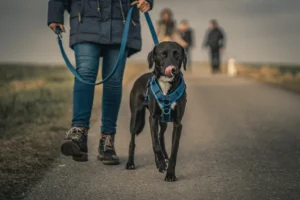Consider how monotonous your life would be if you never got to walk outside. However, when it comes to dogs, lots of people aren’t sure whether not walking them is cruel or not.
Whether or not walking a dog is animal cruelty will depend on the dog’s breed, requirements, and environment. A big yard with lots of play, entertainment, exercise, and training can mean less walking or none at all. However, the mental stimulation walking provides may still be needed.
We are ethically obligated to provide our dogs with an excellent quality of life. And “quality” for most dogs would entail exercise, mental stimulation, and social connection.
If you can achieve that without walking the dog, then the dog is probably OK with it, and you’re good.

Why Do Dogs Need to Be Walked?
Regularly walking your dog gives a solid foundation for physical and emotional well-being.
Walks are used for much more than merely burning calories. Twenty-minute walks away from the property are the most critical predictor of dog retention, implying that your relationship with the dog will improve.
Walking dogs can help lessen territorial aggressiveness because each new person they meet is not invading their territory.
Enrichment, which are activities and situations that allow an animal to exercise species-particular behavior, such as sniffing, running, and exploring for a dog, is required at all times. It is necessary for health. Walking provides all that.
It’s a terrific method to work on proofing his training away from your residence while distracted. He will be exposed to a wide range of stimuli. The best part is that it’s a great way for you and your dog to bond.
During the day, dogs tend to sleep a lot. But they like to be awake when you are, so they usually sleep when you are sleeping or not around so they can make the most of the time when you are there. They have a lot of fun strolling alongside you, so why not have fun with them?
What Happens if You Don’t Walk Your Dog?
If you do not take your dog for a walk, they will never learn to distinguish between different smells and may refuse to visit any new surroundings. Not taking them for walks may cause them to become hard to deal with once you do. They may pull hard on the leash and even be aggressive toward people.
If you’re taking your dog out after a long time, the dog will pull hard on the leash because they are so happy to go outside, where they never get to go. This can be improved by training and switching to a head harness for better control.
Similarly, if you’ve never taken your dog outside to socialize, they may become aggressive toward strangers, and may even develop behavioral issues, like excessive barking or chewing, stemming from pent-up energy and frustration.
Because you have not tried to train or socialize your dog, they will undoubtedly pull and bark. The only way to correct this is to continue walking and training them.
Chronic neglect in providing essential outdoor activities can lead to obesity in dogs, a prevalent health issue that many pet owners overlook.
If you’re thinking of getting a dog but not going to walk them, ask yourself why to get a dog if you aren’t prepared to give a critical component of their care.
How Often Should Dogs Be Walked?
We recommend walking the dog at least once daily, regardless of breed. Whether a companion breed or not, every dog deserves at least one daily walk to sniff, explore, and get out of the house. It aids with exposure, self-esteem, socializing, and training.
No matter how old your dogs are, they shouldn’t have to wait more than 8 hours to go for a walk, but it depends on the breed. Hounds, for instance, require a lot of social interaction, whereas some working breeds and guard dogs are OK for 10–12 hours.
Some breeds should be walked less frequently. Because of their flat face, pugs are prone to breathing problems. Thus, breeders and vets advise against excessive exercise and walking for pugs. Usually, it’s no more than 20 minutes each day and no more than twice weekly.

Do You Need to Walk Your Dog if You Have a Yard?
If the dog has a big yard, is not chained, and plays with other dogs, it may not need to go for walks daily. Depending on the breed, the dog will probably be happy if he can go out in the yard whenever he wants to.
If you’ve never walked your dog and intend to, then walking them in your yard will accomplish little. When you finally take the dog out and think it is excellent on a leash, it may go back to pulling and barking the moment they step outdoors because they have been trained in a perfectly controlled area with no distractions.
Even if you have a yard, try taking your dog for an occasional stroll. First, it’s probably good for both of you to get out and about. It helps you work on your dog’s reactivity, gives you some exercise, and gives him some extra training and stimulus.
Suggested Read: Check these Training aids for leash pullers
Can You Report Someone for Not Walking Their Dog?
Seeing a canine companion consistently indoors can certainly stir one’s curiosity and concern. But it’s crucial to discern between a lapse in walking and genuine neglect. Life is unpredictable; an injury, a family emergency, or sheer exhaustion from work might momentarily impede regular dog walks.
If you’re genuinely worried, initiate a friendly conversation with the dog owner. “Hey, I’ve noticed Max hasn’t been out as much. Is everything okay?” Such an approach opens a door for understanding rather than judgment.
It’s astonishing how a bit of compassion can sometimes bridge gaps and create community solutions. Perhaps you could even volunteer for an occasional walk or introduce them to local dog-walking services.
Consistent denial of essential care, however, is a different ball game. If the dog displays overt signs of distress or deteriorating health and the owner remains indifferent, it’s more than a simple missed walk.
In such cases, can you report them? Yes, you can. Your local animal welfare organizations are well-versed in addressing these concerns. They can offer guidance, resources, and, if necessary, intervention.
Involving authorities should always be a last resort, after personal attempts and community resources have been exhausted. After all, the overarching aim is ensuring the dog’s happiness and health, not penalizing its human.
Can You Replace Walking With Something Else?
If you cannot walk your dog, another form of physical activity can be a suitable substitute. It does not have to be a stroll through the park every time.
Playing ball is a decent, occasional substitute. Physically it is a better exercise than walking. However, it may not be as mentally stimulating as walking is.
Combining activities such as chasing the ball with mentally engaging activities such as obedience exercises/nose games/hide and seek, etc., can be an excellent substitute for a walk.
Ball fetching is a great substitute, but it depends on the dog. If your dog loves ball fetching, it’s a good thing to do. If your dog just wants to walk around and relax, let him. However, most dogs would prefer to be more physically active, and they’ll help you stay fit as well.
Engaging your dog in agility training, even at a basic level, can also be a wholesome alternative to regular walks, offering both mental and physical stimulation. For some dogs, it’s best to take them to a sports park with plenty of space to run and exciting smells to sniff. Otherwise, it’s probably a poor substitute, especially for a large dog.
Choose a pug if you’re lazy or intend to avoid walking your dog frequently. They require less exercise than other breeds and can be pretty lazy.
FAQs
What other things regarding a dog are animal abuse?
Physical assaults, kicking, or beating a dog are all forms of animal abuse. Aggressively dragging your dog around, slapping, holding grown dogs by their necks, not feeding them properly, and keeping them closed constantly can all be considered abuse and neglect.
Should you report someone for not walking their dog?
If you have seen and have evidence that a dog is being neglected, you can report them. However, simply not walking a dog may not be enough to make a change. If there is other evidence, such as a dog being outside in cold weather, that might work.
If you have a lot of free time and some good will, you could also ask them to walk their dogs from time to time. However, try to phrase the offer, so it sounds like it’s benefiting you and not judging them.
Why do some people not walk their dogs?
Some people have huge yards and several dogs where dogs are free to roam and socialize with each other. Other times, people are lazy, don’t prioritize pet care, or don’t understand that walks are more than burning energy but also crucial for the mental well-being of their dog.
Alex, a passionate animal lover, has experience in training and understanding animal behavior. As a proud pet parent to two dogs and three cats, he founded AnimalReport.net to share insights from animal experts and expand his knowledge of the animal kingdom.









